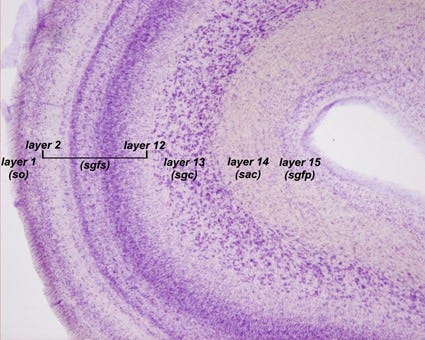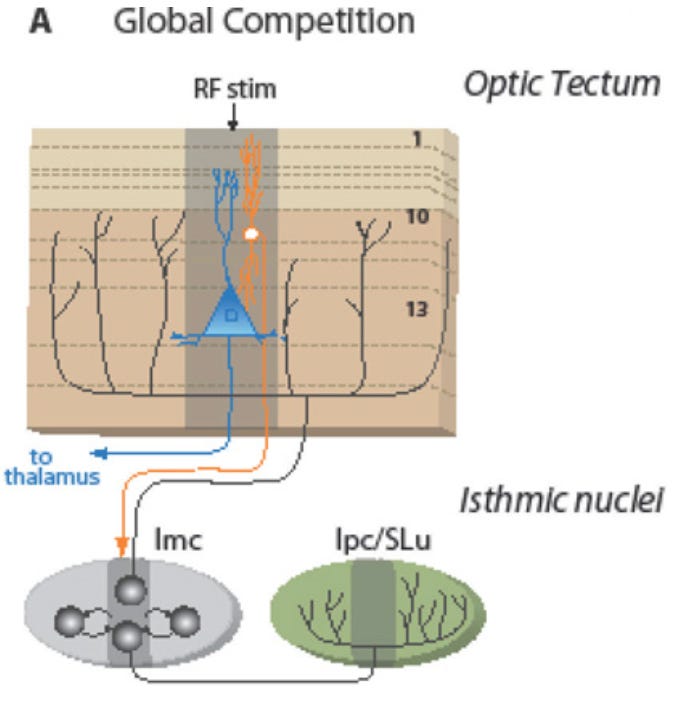The Basis of Attention in Humans and Owls
The story of the Optic Tectum
a foreword,
I’d like to thank Adam Mastroianni for giving my post ‘The Best Antibiotic for Acne is Non-Prescription’ Second Place in his Blog Extravaganza. This generated a bunch of traffic to my blog and subsequently a bit of nervousness as to what I’d write about for my next post! I’ve settled on discussing a pretty specific topic/region in neurobiology, but it is one that I believe has generalizable insights to other brain regions like the Cortex and to frameworks like Predictive Processing.
Without further ado…
Priors
I believe many of my readers will be familiar with the term ‘Predictive Processing’ but for those who were among the first to start reading my blog (my friends and family) I will summarize it as such:
Your brain constantly maintains a model of the world that includes the spatial, emotional, and sensory information that make it up.
This ‘World Model’ runs in the background of your experience, whenever something new is encountered it is rendered into your brain as schemata
Sometimes this ‘World Model’ is not accurate to actual experience. An example of this is could be putting a random color generator in your peripheral vision and then realizing your guesswork is almost worse than chance
The brain has physical processes analogous to this; The Parahippocampal Cortex encodes the meaningness of objects in your vision, the Limbic System encodes the emotional reaction to such objects, and the Prefrontal Cortex (we can absolutely get more specific for all of these examples) determines the appropriateness of this response.
The continuous learning period of childhood and adolescence is a time in which the learning rate of this ‘World Model’ is highest. This means that new information will color experience with greater and broader strength until it is encountered with contradictory information. For instance, I believed for the longest time that the word mischievous was pronounced “Mis-Chi-Vi-Us” and my speech reflected this until I was around 17 upon which my mother informed me that the more common pronunciation was in fact “Mis-Che-Vus” (this is a very common mistake).
Some schema in the ‘World Model’ are nearly impossible to overcome, especially those of which relate to the visual system. Take for instance the Hollow-Mask Illusion; introduced to me by Scott Alexander’s hilariously titled blogpost, “Why Are Transgender People Immune To Optical Illusions?”

The brain has an incredibly strong prior/schema against viewing faces as anything but outside in, such that even when the hollow mask rotates inside out – it sort of “snaps” (I thought this was an Alexanderism, but I can’t find the post where he uses this term) back to being outside in again.
Further reading on Predictive Processing can be found by searching the term on Lesswrong, Slate Star Codex, or even my own blog. I will not be the first, nor the last to talk about how cool it is.
The Neurobiology (the horror) of it All
These 'World Models’ and Schema have to come from somewhere of course, and there is no better training data than reality itself! Looking further and further back into the primal parts of the human brain we can find exceptionally fun systems, made without complicated synaptic machinery like the “Triheteromeric NR2A/2B NMDA Receptor”.
These systems are hesitant to change as they make up the very basis of sense data, yet the computations they perform require rich and complicated morphologies. The 'Superior Colliculus’ – known in Owls and other animals as the ‘Optic Tectum’ – is one such brain region. I initially became interested in it because it lacked many of the synaptic mechanisms that are considered essential for the cortical processing of information, namely the NR2B-NMDARs mentioned above. This is because, without NR2B-NMDA Receptors, you simply could not remember the placement of items in a novel space (similar results can be attained by getting blitzed on Ketamine). The lack of complex plasticity mechanisms in this circuit (at least in adulthood) point to its importance as a signal transponder of visual stimuli.
In the absence of these mechanisms at the synaptic level, how can the Optic Tectum perform tasks like Motion Detection, Signal-Noise filtering, and Discrimination of Attention?
Structure
The Optic Tectum is a layered structure — much like the cortex — with smaller bundles of neurons at the very center. The outside layer of the Optic Tectum can be thought of like a slice of a sphere with numerous columns inside of it, each column representing a group of neurons that relay input from the visual field to the Brainstem and Thalamic Nuclei. If you imagine your visual field as a grid, the content of each one of the cells in that grid can be represented by one of these columns. The outputs to the Brainstem and Thalamic Nuclei (specifically the dorsolateral geniculate nucleus) make it such that signals in the Optic Tectum cause the eyes to move reflexively towards the object of excitation.
The inner layer of the Optic Tectum behaves similarly, however it also integrates signal from the auditory cortex and other sensory modalities. Outputs from the inner layer project to the Brainstem where excitation produces reflexive/“ballistic” movements in the rest of the body (this will be important later). It also sends information to the Thalamic Nuclei; however, only to those that guide voluntary movements.
This region can be subdivided further, but frankly there is not enough data to determine the function of each of the proposed FIFTEEN layers. Two will make due.
Circuits
In order to discriminate whether or not stimuli is actually meaningful or “salient” there must be a mechanism that allows only one or a few local columns to fire at any given time. If the whole Optic Tectum were to fire without rebound inhibition you could not direct your focus on any thing in your visual field. Thankfully for us – and for nearly every vertebrate with eyes – rebound inhibition is a huge part of this circuit!
At the very center of the Onion(Optic!) Tectum lie a bundle of neurons called the Isthimic Nuclei. Any time a column in the Optic Tectum fires, it causes this bundle of neurons to fire as well. Rather than inducing excitation in the whole region, the Isthimic Nuclei inhibits every column and prevents any of them from sending output to the aforementioned Thalamic Nuclei, Brainstem, and Basal Ganglia. The Neurobiology professor Eric I. Knudsen refers to this as “competitive surround”.
The blue neuron in this image represents one of the neuronal columns I referred to prior. The two Isthmic Nuclei – Imc and Ipc/SLu – are responsible for the global inhibition as seen by the black neuronal fibers that reach into the Optic Tectum. The Orange neuron depicted is a neuron that accompanies each column that senses excitation for the Isthmic Nuclei so it can induce the “competitive surround”.
Because the brain is a noisy place, there’s excitation in every column; however, the amplitude of this excitation is variable. Only one column, one cell of the visual field, with the greatest excitation, the greatest motion/light/color, is able to project beyond the onion and to the rest of the brain. In the case of the owl, upon sensing the slightest movement in the bottom-left corner of its vision, the eyes immediately shift focus, ballistic movements trigger direction turning in midair, and a surge of dopamine and noradrenaline hit, all within milliseconds. Moments later a dead mouse lies on the forest floor.
From Birds to Humans
The Optic Tectum is a primitive region of the brain that shows up in nearly every vertebrate with eyes, it turns out those organs are effectively useless if an organism doesn’t have the ability to visually focus. In humans and primates, the Optic Tectum gained extra functions and was given the name ‘Superior Colliculus’. The interior layer especially broadened its ability to integrate various sensory modalities, so much so – that some neurobiologists theorize that it is “Causally engaged in Abstract Higher-Order Cognition”. Given how recent the studies determining the higher functions of the Superior Colliculus are – I don’t feel comfortable drawing dramatic conclusions about them as I would with the Optic Tectum.
It is worth mentioning however, the synaptic mechanisms I mentioned were absent in the Optic Tectum are in fact present in the Superior Colliculus, owing to my suspicions of higher order function.
With that, I hope you enjoyed reading and I hope that you point out anything I missed in the comments!
Further Reading and Works Cited
Further Reading on the Superior Colliculus can be found in these articles:
- Primate superior colliculus is causally engaged in abstract higher-order cognition
- Pathways for Naturalistic Looking Behavior in Primate II. Superior Colliculus Integrates Parallel Top-down and Bottom-up Inputs
- Morphology of Superior Colliculus- and Middle Temporal Area-Projecting Neurons in Primate Primary Visual Cortex
Some Lesion studies are also helpful to get a feel for how important this region is:
- Visual Neglect After an Isolated Lesion of the Superior Colliculus
- Superior colliculus lesions preferentially disrupt multisensory orientation
And of course the work that inspired this blog:
- Neural Circuits That Mediate Selective Attention: A Comparative Perspective



